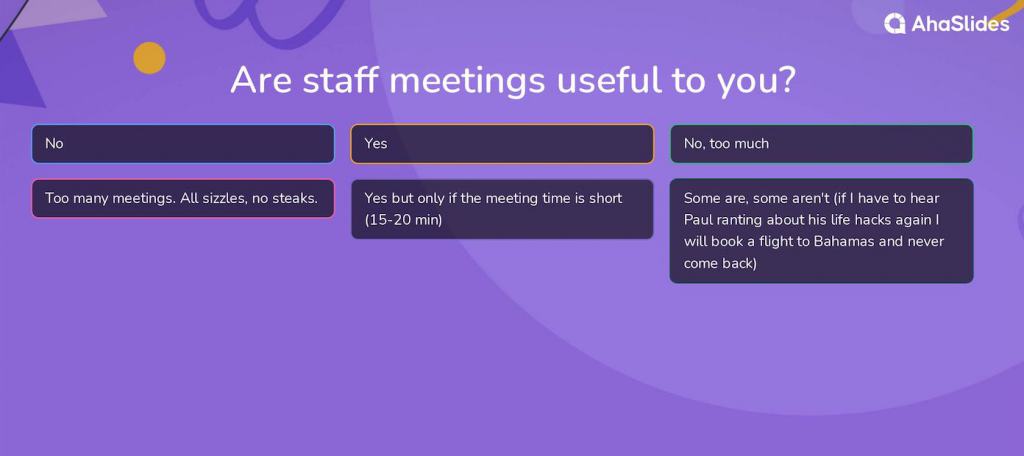Staff meetings should be productive power hours, right? But too often they're just status report snoozefests. Learn these 10 commandments of Meetings 2.0 to transform your team discussions into dynamic decision-making sessions where everyone levels up!

Table of Contents
- Are Staff Meetings Useful?
- 10 Rules to Make Your Staff Meeting More Engaging
- How to Level Up Staff Meetings
- Frequently Asked Questions
Are Staff Meetings Useful?
Are staff meetings really necessary or just a waste of precious hours? As any savvy entrepreneur knows, time equals money - so is it smart to regularly block out big chunks for "meetings"?
Heck yes! When done right, staff meetings are valuable tools that take your business performance to the next level.
First up, comms is key - meetings are ideal for important announcements, status updates and making sure everyone's on the same page in a way emails and texts just can't match.
Coordination is also clutch - hash out goals, projects and client stuff together and suddenly silos disappear as collaboration skyrockets.
Problems? No problem - meeting time transforms challenges into opportunities as a crew collectively cooks up solutions.
And the vibes? Forget morale - these check-ins straight up cultivate chemistry that fuels motivation as colleagues connect and feel part of something lit.
Poll Your Staff to Facilitate Discussion
Get opinions on what's going on in their minds about literally everything with our polling platform! Being flexible is the key to retaining top talent.

10 Rules to Make Your Staff Meeting More Engaging
Nothing turns people off faster than boring, one-sided monologues disguised as staff meetings. But it doesn't have to be that way. With these pro tips, participants will go from no-show to must-attend in no time!
Rule #1 - Prepare Beforehand
Coming prepared for the meeting should be the first priority. You should review the agenda and any relevant materials beforehand. This shows respect for everyone's time and enables you to participate in the discussions actively.
You might want to check out meeting-related topics here:
Rule #2 - Be Punctual
Time is gold. No one should have to wait for you. By arriving on time for staff meetings, it goes beyond just showing respect for others' time; it reflects your commitment, professionalism, and dedication to your work. It also ensures that important topics are addressed without unnecessary delays or disruptions.
If you are caught up in too many things and can't attend, notify the organizers in advance (1 day for informal and 2 days for formal meetings).
Rule #3 - Participate Actively
Active participation is crucial for effective staff meetings. When you actively engage in discussions and contribute your ideas and insights, you enhance the overall quality of the meeting and help drive the team towards achieving its goals.
Rule #4 - Follow Meeting Etiquette
Adhering to proper meeting etiquette is essential for maintaining a respectful and productive atmosphere during staff meetings. Disruptive behaviors are the catalyst for low-quality meetings, so protocols such as following the dress code, giving your full attention to the speaker, avoiding interrupting and using electronic devices during the meeting if necessary.
Rule #5 - Take Notes
One of the most important parts of participating in staff meetings is note-taking. It helps you retain important information, track action items, and refer back to discussions later. It demonstrates your attentiveness and ensures that key points are not forgotten. Effective note-taking enhances your engagement and contributes to more effective follow-up and implementation of decisions.

Rule #6 - Don't dominate the discussion
It's important to create a balanced and inclusive meeting environment where everyone's voices are heard. Avoid monopolizing the discussion and give others an opportunity to share their ideas and perspectives. The best staff meetings should facilitate active listening, encourage participation from all team members, and foster a collaborative atmosphere that values diverse input.
Rule #7 - Don't Forget Teamwork
Staff meetings shouldn't be solely focused on formalities and pressure, especially the first staff meeting with a new team. It should go with a cozy and pleasant place to get team bonding and connection.
To strengthen new bonds, consider having a small icebreaker round before discussing the main items. We suggest these small games:
- Spin the wheel: Prepare some fun prompts and put them on the wheel, then designate each person to take a spin. A simple spinner wheel activity can let you unlock your colleagues' new quirks real quick.

- Team battle: Prepare some quizzes, set up team-play, and let teams compete against each other for the battle of glory. You can set up a quick team play here. We have a library of unmissable quizzes ready to use so no time and effort is wasted!
Rule #8 - Don't interrupt or speak over others
Inclusive communication is key during staff meetings. Be mindful not to interrupt or talk over others, as it can hinder collaboration and diminish the value of diverse perspectives. Give everyone a chance to speak and contribute fully by actively listening and waiting for your turn to speak. This fosters a culture of respect, collaboration, and enhances the overall quality of discussions and decision-making.
Rule #9 - Don't shy away from asking questions
Don't hesitate to ask questions during staff meetings. Your curiosity and inquisitiveness can spark insightful discussions, illuminate important matters, and contribute to better understanding. By seeking clarification, sharing your genuine interest, and fostering a culture of learning, you inspire others to engage and contribute their own perspectives. Remember, every question has the potential to unlock new ideas and drive the team forward.

Rule #10 - Don't lose sight of time
In order to maintain professionalism during staff meetings, it is crucial to have a keen awareness of time. Respect the allocated meeting duration by starting and ending on time. Conducting a staff meeting successfully starts with keeping discussions focused and avoiding veering off-topic to ensure efficient use of everyone's time. By demonstrating time management skills and upholding professionalism, you contribute to a productive and respectful meeting environment that maximizes outcomes for the team.
Level Up Your Staff Meetings with AhaSlides
Crew meetings have the potential to bring the wow, if only we harness our team's collective brainpower. Engage them in two-way discussions with AhaSlides' live polls, quizzes, voting features and many more.

Start in seconds.
Get free templates to hack your meeting effeciency to another level! Sign up for free and take what you want from the template library!
🚀 To the clouds ☁️
Frequently Asked Questions
What is a virtual staff meeting?
A virtual staff meeting is a meeting conducted online or through digital platforms, where participants connect remotely from different locations using video conferencing or collaboration tools. Instead of gathering in a physical space, participants join the meeting virtually using their computers, laptops, or mobile devices.
What is a good staff meeting?
A good staff meeting has a well-defined purpose, structured agenda, efficient time management, and promotes teamwork and collaborative problem-solving. Meeting follow-ups need to evaluate the effectiveness of the meeting and gather feedback from participants.
What are the types of staff meetings?
There are several types of staff meetings as follows: Onboarding meetings, Kickoff meetings, Feedback and Retrospective meetings, Introductory meetings, Status update meetings, Brainstorming meetings and One-on-one meetings with staff.
Who leads a staff meeting?
The leader of a staff meeting should be someone who can effectively manage the meeting process, keep discussions on track, encourage participation, and ensure that the meeting objectives are achieved.
Ref: Forbes








